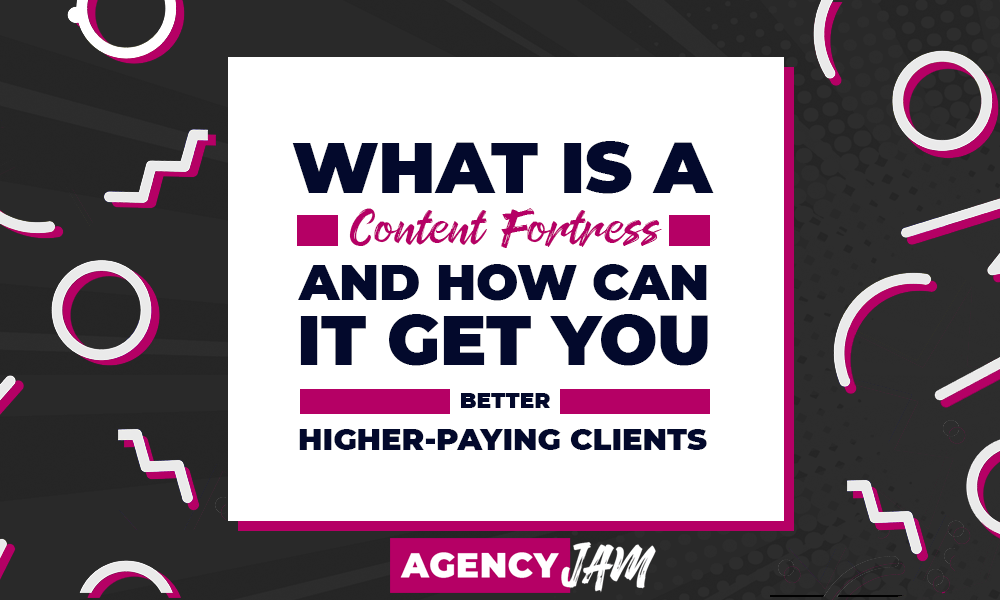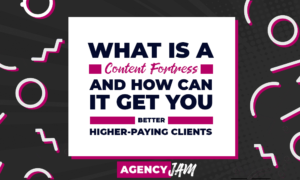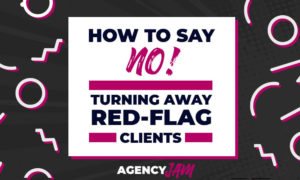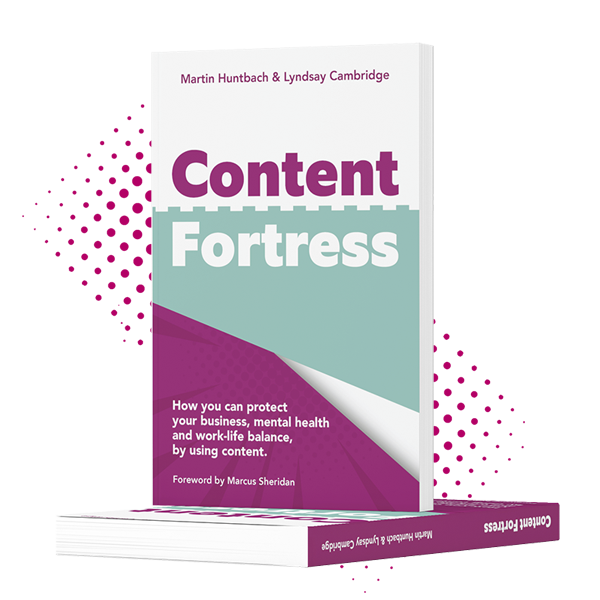What is a Content Fortress and how can it help your agency get better, higher-paying clients?

I distinctly remember speaking to a fellow agency owner a few years ago. She said to me, ‘One day, I want to run a successful agency just like you and Martin.’
And I smiled and thought to myself, ‘Oh no you don’t.’
Because on the outside, we appeared successful.
Unfortunately, we were miserable.
We never had to think about where our next client was coming from. But we were stressed. We had to constantly communicate with clients – chasing after them for things we needed or explaining our processes. We dealt with scope creep and unreasonable demands. We would have to chase for payments constantly. And we were always working. Our weekends and evenings were crammed with client work. It was all work and no life.
The stress impacted Martin physically too. And he had to go through months of some pretty scary tests just to find out that our agency was doing serious damage to his mental and physical health.
We felt like frauds. Projecting success when behind closed doors we drowned in client work and constant problems.
It was only after a particularly difficult conversation with a client who had a ‘build it and they will come’ mentality to his website, that Martin bashed out a blog post called ‘Why Your Website Might Fail.’
And that’s when Content Fortress was born (although it didn’t have such a cool name at the time.)
We realised that we’d used content to grow our business. So we thought to ourselves, if we can use content to grow our business, can we use it to protect our business – to protect our time, to protect our mental health, and to protect our future?
What is a Content Fortress?
A content fortress is a proactive prevention strategy – a way of using content to prevent problems in your business.
It’s not about getting more leads and sales (although that is a nice side-effect). It’s specifically about using content to…
- Protect your time
- Get a better, healthier work/life balance
- Take on fewer clients (but charge more)
- Work with better clients who respect what you do
The Content Fortress in Action
We’d had experience designing websites for brand new business owners and it never ended well (for either party).
For the new business owner, spending thousands on a website didn’t work because…
- They hadn’t validated their idea
- They weren’t clear on their audience
- They were already in a big minus before they’d even started their business
And for us, working with new business owners didn’t work because…
- They took up a lot of time and hand-holding (as they didn’t know much about starting a business and what that entailed)
- The projects took longer because they had no existing brand or website copy
- They expected their website would bring them riches straight away – and we felt shitty when it inevitably didn’t
So, we created a blog post called, ‘Why New Business Owners Shouldn’t Spend Thousands on a Website’
We did this because we didn’t want to work with new business owners. Because we knew, deep down, it wasn’t the best thing for them or us. Creating this content held us accountable to that.
But more importantly, it increased the loyalty with our preferred customer base (those with more established businesses). Because they could see that we were picky. They knew we weren’t for everyone and we weren’t out there to make a quick buck.
This is the power of Content Fortress content. It helps you prevent problems (like taking on a new business owner) but also get more leads and sales from the right people.
Why Content?
You might be wondering why we choose content to communicate all this. Why not wait for a new business owner to get in touch, for example, and then explain why you can’t work with them?
The obvious answer is it saves you time.
But actually, there’s a deeper reason…
‘People don’t care what you say, they care what you publish.’
Unfortunately, talk is cheap.
And published, public content is way more trustworthy than you talking privately to someone.
This is exactly what happened when we would tell companies we would not pitch for projects. They’d request a pitch and we’d send them a polite reply declining but offering to have a call with them instead to discuss the project. They refused. And we had some pretty pissed-off replies from people who assumed we were too egotistical to pitch and didn’t want to work with them.
So we published this article – why we don’t pitch for projects.
And instantly things changed. They believed us. It wasn’t something personal to them, this was a company-wide thing we’d adopted.
And we landed big clients without having to pitch. Win!
The Eight Pillars that Make a Content Fortress
A content fortress is made up of eight separate pillars.
1. Repelling Content
There’s a lot of talk about attracting your ideal clients. But not so much about repelling those who are the wrong fit. You have to actively repel the ‘wrong fit’ clients. And you have to do this BEFORE they get in touch. Why? Because you don’t want these people taking up any of your time. You don’t want them disrupting your day. That’s why content is the best way to do this.
An Example of Repelling Content: ‘Why We’re Not the Right Fit For You’
2. Attracting Content
In the same way as repelling content, you have to ‘actively’ attract your dream clients. The problem is, our ‘dream’ clients aren’t always paying attention to us. You need to create content that proves to them that your products or services are helpful and relevant–even if they’re unaware of you, your product. Or even if they don’t think you can help.
An Example of Attracting Content: ‘Why Large Businesses Should Invest in a Freelance Web Designer’
3. Sales Content
Sales content is for those lurkers who are ‘on the fence’ about working with you. They know who you are, and they know how you can help. But they’re still a little unsure. This kind of content gives them the push (or shove) that they need. It gives them the confidence that you’re the right company for them. It sells your services just like a good salesperson could face-to-face.
An Example of Sales Content: ‘Everything You Need to Know About My Web Design Service’
4. Pricing Content
Every single customer who gets in touch with you will ask you about the cost of your products or services. But the kind of ‘pricing content’ we’re talking about goes way beyond talking about the cost of your products or services. It’s about creating specific pieces of pricing content that will attract your ideal customers and keep your current customers happy. It’s not ‘here’s what I charge’. It’s ‘this is why I charge what I charge’.
An Example of Pricing Content: ‘How Much Does it Cost for a Website (and How Much Do I Charge?)’
5. Guiding Content
Guiding content is content that helps your prospects become better, more well-informed customers. This means by the time you take them on as a client you spend less time educating them. You get started on the project or deliver the product much quicker, and your customer feels completely at ease.
An Example of Guiding Content: ‘How to Find the Right Web Designer For You’
6. Process Content
Process content tells your customer exactly what is happening at every stage of the buying journey. From the moment your customer hands over their precious cash, to the moment you deliver your product (and beyond) they should be informed about your process and what happens next. This is a biggie in terms of keeping your customers happy.
An Example of Process Content: ‘The Step-by-Step Process of Your Web Design Project’
7. Culture Content
Culture Content is a way of using who you are, your values and your story to attract your dream clients. Knowing and promoting who you are and what you stand for isn’t some cringy marketing exercise (well, it doesn’t have to be). It’s vital when it comes to attracting your dream customers. The kind of customers that get you out of bed in the morning.
An Example of Culture Content: ‘Why Do I Do What I Do?’
8. Opinion Content
We all have opinions about what we do. About our work, our customers and our industry. We form these opinions through experience and knowledge. But often, we don’t share these opinions with our prospective clients, and we definitely don’t do it in our content. But we should, because this is the way you can attract like-minded customers who you’ll love to work with.
An Example of Opinion Content: ‘Why Your Website Won’t Be Successful’
Where do you start with Content Fortress Content?
If you want to attract better, higher-paying clients, then check out our Content Fortress book or course.
Want some more?
Of course you do. Check out these articles...

What is a Content Fortress and how can it help your agency get better, higher-paying clients?

Why Every Agency Needs to Create ‘Sales Content’ (and how to do it)


How to Use Content to Transform Prospects into Your Dream Clients


